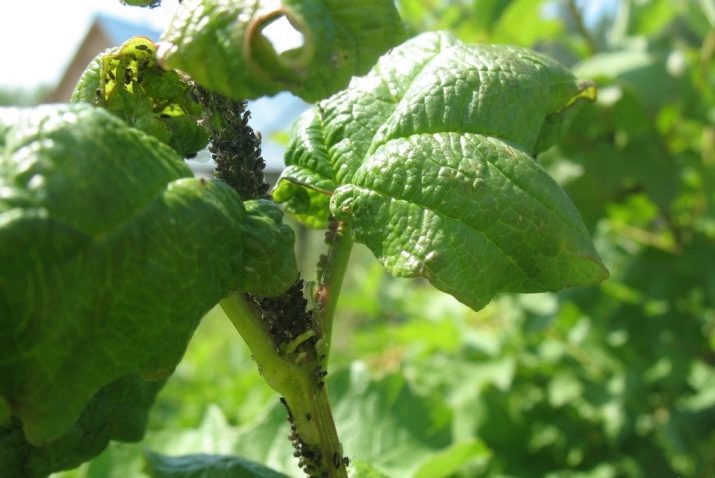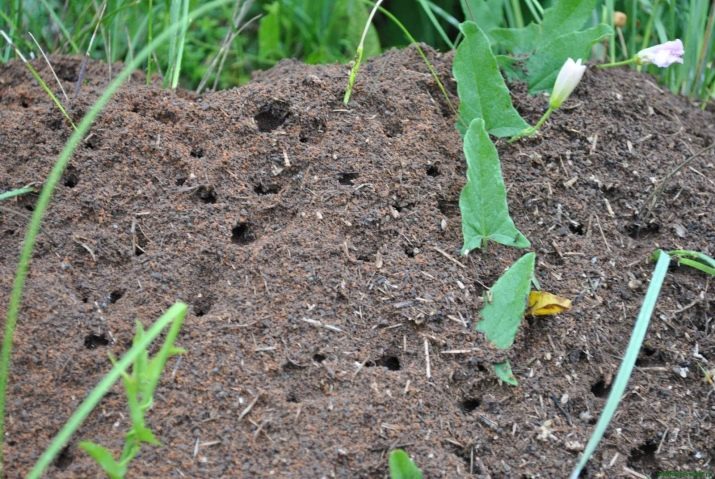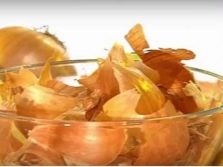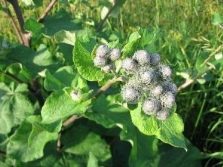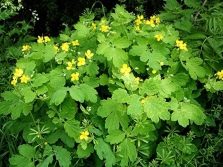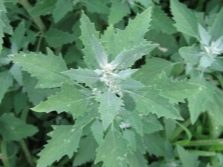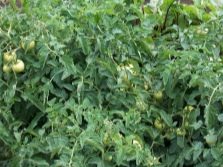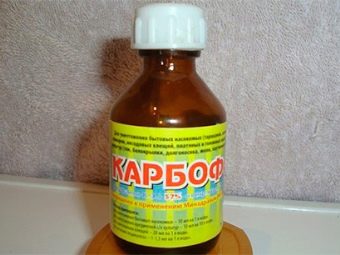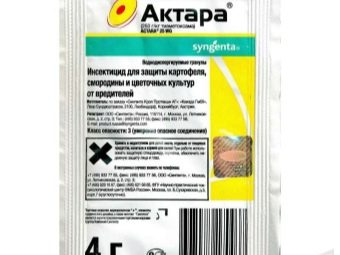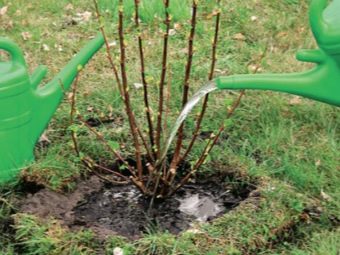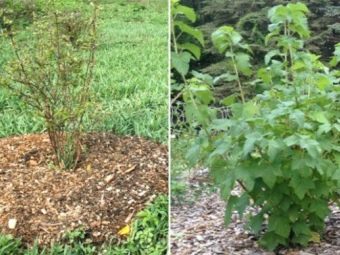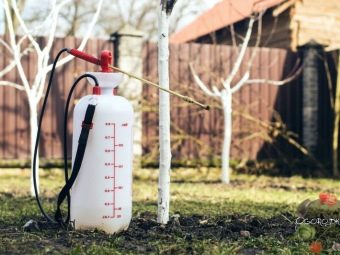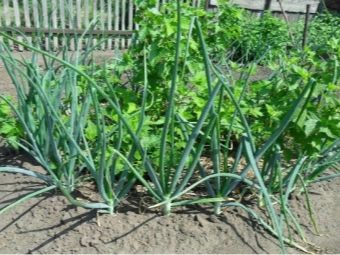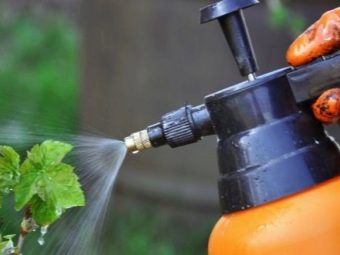How to deal with aphids on currants?
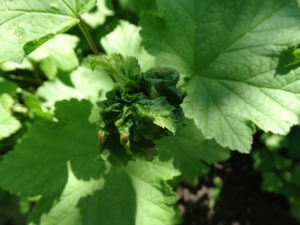
Aphid is one of the most famous and common pests in the garden.This type of insect parasitizes mainly on fruit and berry crops, including currant bushes. Insects breed most actively in the summer when heat and drought occur. In order to preserve the crop, the gardener must know the basic methods and rules for dealing with aphids.
Signs of defeat
On the bushes of black currant, in most cases, a gooseberry aphid sprouts, while red and white are exposed to species such as red-hallow and currant hairy aphid.
The signs of damage include:
- blistering and blistering on currant leaves;
- coagulation of the leaves into a tube and their further dying off.
The greatest probability of damage occurs with extreme heat, drought and plenty of sunlight. After the appearance of the first aphids in currants, it is immediately necessary to begin the process of the struggle, since during the summer period up to 15 generations of harmful insects change. Separate individuals do not live so long.
The size of the aphids fluctuates around 2 mm, but due to the large accumulation it seems that currants have spots of various shades: gray, greenish or yellow.
Food for pests is the sap of plants that they consume from the inside of the leaf. The appearance of aphids takes away the vitality from cultures, destroys them. All this steadily leads to lower yields of this crop.
It is believed that ant colonies are helpful in evicting aphids. But this judgment is erroneous, they only feed on the waste of harmful insects - honeydew or paddy. As a result, ants even help harmful insects become even more numerous, transferring them to nearby bushes.
That is why it is necessary to fight not only with the colonies of aphids, but at the same time proceed to the destruction of anthills in the garden.
Treatment
Fungal lesions on the currant are formed due to the fact that the gall aphid feeds on the juice of the currant leaves, glaring at them from the wrong side.
It is possible to avoid defeat of a currant as a result of settlement on it aphids in the different ways. The choice of method depends on the degree of damage to the plant, its growth stage (initial, flowering, fruiting).
In the case when a small number of bushes are infected, and insects did not have time to multiply too much, it is better to use folk methods and mechanical methods of removing pests. To make infusions from natural remedies is much safer for the human body, and also they are easy to prepare and use (just spray on the bushes from a spray bottle). Mechanical methods suggest that you just need to remove the insects by hand and remove the affected parts of the plant. These methods are applicable at the stage of flowering and the appearance of the first berries (usually in June).
Chemical methods are suitable in cases where a large number of plants have been exposed to the aphid invasion and it becomes more difficult to destroy its settlements.
Folk remedies
In the fight against colonies aphids are widely used folk methods and means. At the moment, they have accumulated quite a large number, and they act very effectively. So, if you follow all the rules for using popular recipes, you can easily do without chemicals.
Laundry soap has long been widely used in the activities of gardeners. To combat aphids prepare a solution on the water, previously crushed the soap. The chips are stirred in a glass with a small amount of liquid until a thick mass is formed, then it is poured into a bucket of water. Then the mixture is treated currant bushes. Use for this ordinary broom or special devices.
In this solution, you can add a glass of the mixture with ash, but it must first be insisted for at least a day.
Tobacco dust has the most effective effect when mixed with ash. Each element is taken in a dosage of 400 g per bucket of water.Then insist the solution during the day and spend processing bushes.
Instead of ash, you can use the shag. The proportions here will be slightly different: 200 g of each element per bucket of water. For best effect, add hot red pepper (about 40 g). It should be cut as small as possible. After one day of infusion, mix with a couple of tablespoons of liquid soap and a glass of ash.
It is recommended to spray bushes in the late afternoon, and the result is to wait the next morning.
Hot pepper is also used independently. The crushed pods are filled with water in a ratio of 1 to 10, then boiled for 30 minutes. After two days, the resulting infusion is filtered and diluted with water at a concentration of 100 ml per liter before direct treatment.
Onion peels or fresh onions are also widely used. For this you need to take about 200 grams of husk. Since it is very light in itself, it is quite a large number. Therefore, you should never neglect and throw away the remaining husks. Or you can chop the onion head. He also insists in a bucket of water for about 4-5 days. Chives are also used in the fight against aphids.
When using dandelion, take 200 g of this grass (you can directly from the roots) and pour boiling water over it. After pre-infusion, currant bushes are also treated.
Burdock need to apply with the root. Well grind a kilogram of plants and pour three liters of water, then insist for a day. After this time, the solution must be drained, after which it will be ready for use. Be sure to handle the middle of the bush and the wrong side of the leaves. Sprayer is used for best results.
A solution is prepared from soda ash with the following proportions: a tablespoon of soda per liter of water. You can also add a small amount of soap to the solution for better effect.
A special place in the fight against pests is celandine. Its grass is poured with water using the following dosage: 2 kg of fresh plant per 10 liters of water. Insist day, then filtered and sprayed under a currant bush with a spray gun. It should be noted that the celandine is quite poisonous, so it is recommended to wear gloves before processing.
No need to rush to throw out the tops of tomatoes after harvest. To combat aphids, it is crushed and placed in a large container, then poured with water. Two days later, the infusion can be applied. Water the bushes in such a way as to cover as much of the ground as possible at the stems and currant roots.
Aphid also loves quinoa, so this plant will help to divert attention from currant bushes, switching it to itself. After the appearance of aphids, weeds are torn down and burned.
Potato tops are carefully crushed and filled with boiling water in a ratio of 1: 1, then it must be brewed. After two days, you need to strain the mixture and process the bushes to it. Similarly, you can make an infusion of marigolds.
Orange and lemon peel, wormwood, tansy and yarrow will also help in the fight for currants. The recipe is similar to the preparation of hot pepper infusion, but at the end it is not necessary to dilute the mixture.
Ammonia (or simply ammonia) is one of the most effective means in the fight against aphids. When preparing the solution, the following dosage is adhered to: 40 ml of the substance per 10 l of water, it is also desirable to add from 10 to 40 g of soap, which will provide a sticky effect. You can use both liquid and tar soap or laundry soap. In that case when liquid is taken, the dosage changes - 125 ml. For processing suitable spray.
Mustard is used in various conditions, such as powder, infusion, solution or suspension. It is enough just to pour dry powder on the places where pests accumulate, after which the insects will leave the area.
To prepare an infusion in 10 liters of water, dilute 100 g of mustard powder and allow it to brew for 24 hours, then add another 10 liters of liquid and a little soap, previously crushed. Bushes are treated with this infusion after infection, usually a couple of weeks after the start of flowering.
The solution is prepared as follows: dilute vinegar and mustard powder (1 tablespoon each) in 10 liters of warm water, mix well and irrigate currant bushes. You can use a solution containing 100 g of salt and the same mustard powder in 10 liters of water. But in both cases, you need to choose a period without rain, otherwise there will be no proper result.
Suspension can also spray the bushes immediately after its preparation. Aphid does not tolerate the taste and smell of mustard. For its preparation take 6 tablespoons of dry or liquid mustard in 10 liters of water.
No less effectively planted mustard in your garden, it will serve as a good bait for beneficial insects, which are the enemy of aphids. It will also prevent the leaching of necessary minerals and rid the soil of fungi, will contribute to its enrichment with nitrogen, sulfur and phosphorus. Weeds, however, avoid settling next to mustard, which is an advantage.
To handle currant bushes in all cases should be closer to the evening or in cloudy weather. After the rains need to repeat the procedure.
Mechanical methods
At the initial stage of infestation by aphids, and even more so after flowering and ovary of berries on bushes, chemical preparations are not recommended. Therefore, gardeners use mechanical methods to get rid of pests.
In this case, pruning and burning of the affected parts of the plant is done with care. Individuals of aphids are washed off with a hose with water under high pressure and they press pests, not forgetting to wear protective rubber gloves.
When the spring period comes, the infected buds are also disrupted before they bloom. Distinguish such kidneys can be in size and shape. If the insects had time to lay eggs in them for the winter, the buds will be larger and more rounded.
But mechanical methods are quite laborious and laborious. They need to be carried out repeatedly, check the currants for the presence of insects preferably every day. After the appearance of new individuals from the eggs, the procedure begins anew.
Gardeners also use the method of attracting its enemies, such as ladybugs, hoverflies, earwigs and golden eyes, small birds to protect them from being affected by aphids.
Ladybugs very well help to fight with aphids, for which they need to attract them to your garden. Do this by planting tansy, calendula, mallow or nasturtium near the affected crops. The aroma of these flowers will contribute to the settlement of the ladybirds and other enemies of the aphids.
Installed drinking bowls and feeders will help to attract the attention of birds to the garden.
Often, gardeners use the method of fumigating the bushes of a plant to combat aphids. In practice, the use of fumigation with a raincoat, rubber or tobacco is found. Processing currants using this method should be carried out before bud break, when they are just starting to swell.
When fumigating with rubber, a piece of burning rubber is lowered into an unwanted pan or similar container, and then put to fester it alternately under each bush of the cultivated crop.
When fumigating with a mushroom or tobacco, they use the same device, the beekeeper's smoker.
Duration of fumigation of currant bushes is about three hours, otherwise there will be no proper effect. It is recommended to carry out the procedure in the late afternoon, as well as in the absence of strong wind. In this case, you can do without the use of chemical compounds, as the aphid will die without them. The only drawback is acrid smoke, as a result of which you must wear personal protective equipment such as masks (dressings or respirators) and gloves.
Chemicals
In the case when the aphid has already struck a large number of currant bushes, it would be more rational to purchase and use chemical preparations.
The following insecticides will do:
- Aktara;
- "Vofatoks";
- "Inta-Vir";
- Kinmiks;
- Confidorm;
- "Malathion";
- "Rovikurt";
- "Fufanon";
- Fury.
It should be remembered that these drugs have a high degree of toxicity, which is why when working with them it is necessary to use protective dressings and rubber gloves.
For a better result, at least three treatments with chemicals should be carried out:
- before bud break;
- after new leaves appear;
- in the summer, about a month before the first berries.
Also, one should not neglect the instructions of the manufacturers of such substances and take into account their duration, only in this case, their use will be the safest and most effective. Use chemicals at the initial stage of flowering is impossible. Apply in this situation it is better to use drugs such as "Fitoverm", having a biological origin.
Chemical based preparations are an effective tool in the annual fight against aphids. But substances should be changed, since pests have the ability to develop immunity to poisons.
Prevention
In order to avoid the appearance of aphids, you must initially devote time to proper care for currant bushes, because weak plants are the most susceptible to pests. And for a strong, viable plants aphid is unlikely to pick up, because its small proboscis can not pierce their dense leaves.
The following measures will ensure effective prevention:
- timely watering and processing plants with solutions containing nitrogen;
- pruning of old, sick and injured parts of currants (annually);
- surface coating of mulch soil (peat, straw, cardboard, sawdust) to protect and improve its properties;
- weed removal;
- cleaning the culture stem from the exfoliated bark, as the aphid usually lays eggs there for the winter period;
- fight with ants.
In the latter case, use boiling water, pouring a bucket of water directly on the anthill. This procedure should be performed at the beginning of the spring period. To limit the movement of ant colonies around the currant bush, they dig a small trench and fill it with some kind of sticky compound.
Toward the fall, the soil near the bushes is slightly loosened, and in the spring they produce whitewashing trunks.
You can also treat plants with chemical compounds, but before the first buds wake up. Part of the solution should be poured onto the soil under the currant to provide better protection.
Tips
There are several nuances gardeners need to know when dealing with pests:
- Insects that are enemies of aphids, you can not attract to the site, and settle currants near the bushes on their own. It is quite simple to purchase them in specialized stores or in agricultural markets.
- Near the bushes plants, you can plant crops that have a strong smell, such as onions, parsley, mint, garlic or coriander. Pests do not like these harsh odors and will avoid their landing sites.
- Young shoots of currant bushes have very good flexibility, which allows gardeners to lower them into ready-made solutions and rinse thoroughly, without worrying about breakage or injury.
- Treat each of the branches of the bush in turn with the selected solutions in order not to accidentally miss any harmful insect.
- It is imperative to process the soil near the currant bushes. Processing should be done in the absence of wind.
- Spray need to be careful not to accidentally harm beneficial insects, which will further help in the fight against aphids and other pests.
- First of all, it is necessary to process the inner parts of the sheets, so the spray gun is sent as far as possible into the bush.
The process of dealing with aphids can take a long time.Expect instant results is not worth it, you need to be patient and process, observing all the rules and nuances.
For a better result, an integrated approach is practiced, including preventive measures, baiting beneficial insects and other enemies of aphids, planting plants with a strong odor and mechanical processing, using folk and chemical preparations after the first signs of currant disease appear.
For information on how to get rid of aphids on currants, see the next video.

